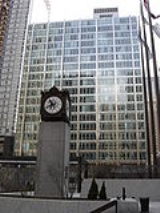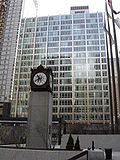
Inland Steel Company
Encyclopedia

Steel
Steel is an alloy that consists mostly of iron and has a carbon content between 0.2% and 2.1% by weight, depending on the grade. Carbon is the most common alloying material for iron, but various other alloying elements are used, such as manganese, chromium, vanadium, and tungsten...
company active in 1893-1998. Its history as an independent firm thus spanned much of the 20th century. It was headquartered in Chicago, Illinois at the landmark Inland Steel Building
Inland Steel Building
The Inland Steel Building, located at 30 W. Monroe Street in Chicago, is one of the city's defining commercial high-rises of the post-World War II era of modern architecture. It was built in the years 1956–1957 and was the first skyscraper to be built in the Chicago Loop following the Great...
.
Inland Steel was an integrated steel company that reduced iron ore to steel. Its sole steel mill was located in East Chicago, Indiana
East Chicago, Indiana
East Chicago is a city in Lake County, Indiana. The population was 29,698 at the 2010 census.-Geography:East Chicago is located at ....
, on the Indiana Harbor and Ship Canal
Indiana Harbor and Ship Canal
The Indiana Harbor and Ship Canal is an artificial waterway on the southwest shore of Lake Michigan, in East Chicago, Indiana which connects the Grand Calumet River to Lake Michigan. It consists of two branch canals, the 1.25 mile Lake George Branch and the 2 mile long Grand Calumet River Branch...
and a large landfill protruding out into Lake Michigan
Lake Michigan
Lake Michigan is one of the five Great Lakes of North America and the only one located entirely within the United States. It is the second largest of the Great Lakes by volume and the third largest by surface area, after Lake Superior and Lake Huron...
. The steel mill's shoreline location enabled it to take in steelmaking commodities, such as iron ore, coal
Coal
Coal is a combustible black or brownish-black sedimentary rock usually occurring in rock strata in layers or veins called coal beds or coal seams. The harder forms, such as anthracite coal, can be regarded as metamorphic rock because of later exposure to elevated temperature and pressure...
, and limestone
Limestone
Limestone is a sedimentary rock composed largely of the minerals calcite and aragonite, which are different crystal forms of calcium carbonate . Many limestones are composed from skeletal fragments of marine organisms such as coral or foraminifera....
, by lake freighter
Lake freighter
Lake freighters, or Lakers, are bulk carrier vessels that ply the Great Lakes. The best known was the , the most recent and largest major vessel to be wrecked on the Lakes. These vessels are traditionally called boats, although classified as ships. In the mid-20th century, 300 lakers worked the...
. Throughout much of its life, Inland Steel operated its own fleet of bulk carrier vessels.
Firm history

Chicago Heights, Illinois
Chicago Heights is a city in Cook County, Illinois, United States. The population was 31,373 at the 2005 census. Chicago Heights is nicknamed 'Crossroads of the Nation'.-History:...
steel mill, Chicago Steel Works. The Block family led Inland Steel's recovery and, in 1901, Inland Steel pledged to raise more than $1.0 million to build an open-hearth
Open hearth furnace
Open hearth furnaces are one of a number of kinds of furnace where excess carbon and other impurities are burnt out of the pig iron to produce steel. Since steel is difficult to manufacture due to its high melting point, normal fuels and furnaces were insufficient and the open hearth furnace was...
mill in East Chicago. This expansion caused the firm to grow more than tenfold in size, from 250 workers in 1897 to 2,600 in 1910.
Inland Steel continued to face heavy competition from U.S. Steel
U.S. Steel
The United States Steel Corporation , more commonly known as U.S. Steel, is an integrated steel producer with major production operations in the United States, Canada, and Central Europe. The company is the world's tenth largest steel producer ranked by sales...
, the Pittsburgh-based giant that at that time possessed a dominant share of the U.S. steel market. World wars increased steel demand and pushed Inland Steel forward. In 1917 (World War I), Inland Steel's production broke the 1.0-million ton (0.9m tonne) mark for the first time. By World War II the Chicago-area steelmaker had 14,000 employees and was producing 3.4 million tons (3.0m tonnes) per year.
Starting in the 1950s, Inland Steel specialized in cold-rolled sheet and strip steel for motor vehicle
Motor vehicle
A motor vehicle or road vehicle is a self-propelled wheeled vehicle that does not operate on rails, such as trains or trolleys. The vehicle propulsion is provided by an engine or motor, usually by an internal combustion engine, or an electric motor, or some combination of the two, such as hybrid...
s. In 1956-1957, the successful firm constructed a new corporate headquarters, the Inland Steel Building, in downtown Chicago. Employment at the Indiana Harbor mill rose toward its peak of 25,000 in 1969.
The decline in the U.S. steel industry, starting in 1970, affected Inland Steel. Foreign steel companies were increasing their presence in the world steel market. During the late 1970s Inland Steel formed several joint venture
Joint venture
A joint venture is a business agreement in which parties agree to develop, for a finite time, a new entity and new assets by contributing equity. They exercise control over the enterprise and consequently share revenues, expenses and assets...
s with Nippon Steel
Nippon Steel
, also referred to as , was formed in 1970. Nippon Steel Corporation is the world's 4th largest steel producer by volume.-Early years:Nippon Steel was created by the merger of two giants, Yawata Iron & Steel and Fuji Iron & Steel...
to create I/N Tek and I/N Kote, but profitability continued to be difficult to attain. After a series of internal reforms, Inland rapidly became so profitable in 1997 that, uniquely amongst U.S. integrated steel mills, they became desirable for acquisition. Ispat International
Ispat International
Ispat International N.V. was a steel producing company with operations in Mexico, Trinidad, Canada, Germany and the United States. The company is specialized in the integrated mini-mill process and has a wide range of flat & long steel products, including slabs & wire rods.Lakshmi Mittal was the...
acquired Inland Steel in 1998, and the assets of Inland Steel are now part of ArcelorMittal.
Further reading
- Book, 50 Years of Inland Steel, 1943
- Booklet, “The Story of Inland Steel”, 1964
- Booklets, “Inland Steel at 100: Beginning a Second Century of Progress”, 1993.
- Perry, W.A., Booklet, “History of Inland Steel Co. to 1971", b
- Perry, W. A., Booklet, “A History of Inland Steel Company and the Indiana Harbor Works” (ca. 1980)
- Perry, W.A (1979) A History of Inland Steel Company And The Indiana Harbor Works (booklet)
- Perry, William A. & Saran, Sam H. Booklet, A History of Inland Steel Company and the Indiana Harbor Works (1992).
- Perry, William A. & Saran, Sam H. Booklet, A History of Inland Steel Company and the Indiana Harbor Works(1993).
- Wilder, John Watson Book, Inland Steel, 1893-1943.

